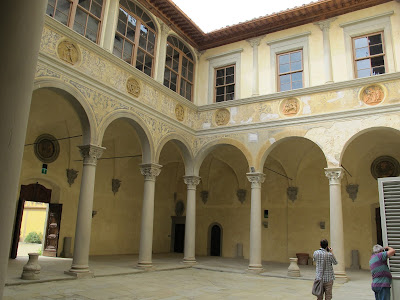Villa
Salviati near Ponte alla Badia
If we
wonder off north, into the hills of Florence, and follow the Via Bolognese, the
world around us slowly changes. The red and yellow colours of the Florentine palazzi,
and the busy noisy streets, are slowly being replaced by small roads with walls
surrounding lush gardens, tall trees peeking over enclosures, and soft rolling
hills. After a little while, the high roof of a large building shows up on our left-hand
side. Walking through the gate, a villa comes into full view. Built in the
fourteenth century as a small castle, and made into a countryside villa by the
patrician Alamanno Salviati in 1445, the building now houses the Historical
Archives of the European Union. It was recently renovated, and beautifully
restored to its former sixteenth-century glory.
Courtyard
of the Villa Salviati
The main
entrance leads us to an open courtyard; a rectangular space with a gallery on
three sides. The space above the round arches is filled with sgraffito decorations.
We can distinguish the imprese of the
Salviati and Medici families. Jacopo Salviati (1461-1533), a rich Florentine
merchant and banker, had inherited the villa in 1490. He was married to
Lucrezia de’ Medici, and their union is represented in these decorations.
Jacopo also commissioned the sculptor Giovanfrancesco Rustici to create sixteen tondi
in terracotta for the same courtyard.
Ceres and
Triptolemos, tondo by Rustici and the cameo from the collection of Lorenzo Il
Magnifico
These tondi,
made between 1518 and 1526, deserve a closer look. All sixteen represent either
a mythological scene or gods from antiquity, and are modelled after existing gems
or cameos. Interestingly, the images are not plain copies of their, sometimes antique,
examples, but seem to be re-imagined by the sixteenth-century sculptor. One of
the tondi shows Ceres and Triptolemos. We know this relief was modelled after a cameo commissioned
by Lorenzo il Magnifico de’ Medici (1449-1492). This image was copied more
often, in different media. We can find it, for example, on the title page of Francesco Rosselli’s book on
Ptolemy, published in 1480 in Venice, together with copies of other cameos from
the Medici collection. It also shows up in a famous painting by Gerard David, the
diptych The judgement of Cambyses from
1498. Here it is placed on the wall behind the ruler, together with an image of
Apollo and Marsyas.
Detail of the frontispiece of Francesco Rosselli’s Ptolomy and Gerard David’s The
judgement of Cambyses
Another
example is Rustici’s tondo with Bacchus and Ariadne. This
scene is based on an antique gem, named the gemma
mantovana, from the collection of cardinal Giovanni Grimani (1506-93). It is very probable that this gem was once part of the collection of
Lorenzo de’ Medici, and came into possession of the cardinal much later. This
same gem was also used as an example by the artists that designed the tondi for
the courtyard of the Palazzo Medici-Riccardi in Florence (probably made in the
workshop of Donatello after 1465). For the tondo in the Villa Salviati, Rustici
slightly adjusted the image.
Tondo with Bacchus and Ariadne in the
Villa Salviati, the gemma mantovana, and
tondo with Bacchus and Ariadne in Palazzo Medici-Riccardi
A further comparison between
the courtyard of Palazzo Medici and that of the villa Salviati reveals more
similarities, for example the sgraffito decorations between the tondi. Because Jacopo
married a Medici, we can be certain he was familiar with the
decorations of Palazzo Medici. When Rustici was commissioned by cardinal Giulio
de’ Medici in 1515 to create a sculpture for the same courtyard, he must have seen
these tondi first hand as well. It is very likely, therefore, that Jacopo Salviati was inspired by Palazzo Medici and its specific
decorations, and decided to recreate this in his own villa. It was a deliberate
choice, and he was aware of the connotations. By
emulating the Palazzo Medici, he was able to show that his family, the Salviati, was equally important,
or at least able to compete with the Medici.
Courtyard
of Palazzo Medici Riccardi
During a
raid in 1529, the villa, and the nearby Villa Careggi of the Medici, were set
on fire by a group of young men from Florence. Although the Medici family had
been driven out of Florence two years earlier, the aversion against this family
and their potential return to the city had a group of angry anti-Medici
patricians fired up. They gave full vent to
their resentment of the Medici and all who
were affiliated with them. This, of course, included Jacopo Salviati and his
wife Lucrezia de’ Medici. Jacopo was in Rome at the time of the attack. When
the news reached him, he was extremely worried about the damage to his
property. Unable to leave Rome, he sent his son Alamanno di Jacopo (1510-1571) to
inspect the villa. It took him some time, but on 12 November 1530 Alamanno finally
wrote to his father that he inspected the house and had reported a lot of
material damage. The courtyard had suffered the most. In his famous Le Vite (1564), Giorgio Vasari even
wrote about the incident. According to him, Rustici’s tondi were almost
completely destroyed: ‘intorno al cortile molti tondi pieni di figure di terra
cotta, con altri ornamenti bellissimi che furono la maggior parte, anzi quasi
tutti, rovinati’ (‘in the courtyard there were many tondi full of figures, made
of terracotta, and other beautiful elements, that were for the large part, or
almost completely, destroyed’). This description does make one think: did Vasari
really see the courtyard with his own eyes after the fire? Because today, when
we visit the villa, we can still find most of the original tondi on the
wall of this beautiful, and politically charged, villa in the Florentine hills.






No comments:
Post a Comment